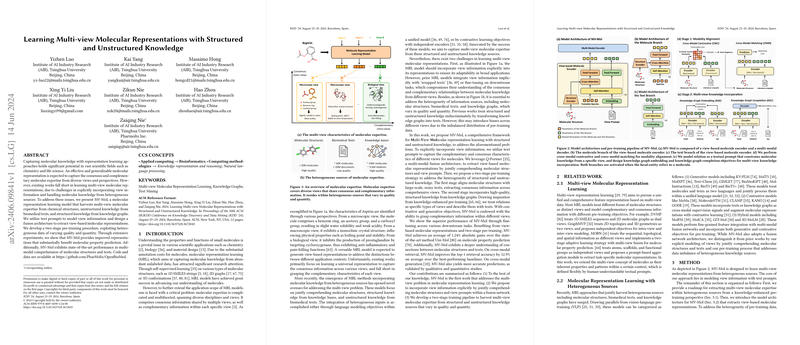Overview of MV-Mol: Learning Multi-view Molecular Representations
The paper presents a model, MV-Mol, which seeks to improve molecular representation learning by integrating multi-view expertise from both structured and unstructured data sources. The main innovation of MV-Mol is its emphasis on capturing the consensus and complementary information across different molecular views using textual prompts. This is achieved through a multi-modal fusion architecture leveraging chemical structures, knowledge graphs, and biomedical texts.
Key Contributions
- View-based Molecular Representations: MV-Mol uses text prompts to encode views explicitly, aligning molecular structures with corresponding semantic contexts. This approach enhances the model's ability to distinguish between different application contexts, offering more flexible and tailored molecular embeddings.
- Two-stage Pre-training Strategy:
- Modality Alignment: The first stage synchronizes molecular structures and texts, optimizing the mutual comprehension of both modalities through contrastive and matching losses.
- Knowledge Incorporation: The second stage integrates structured knowledge by treating relations as textual prompts, enhancing the model's ability to capture high-quality view-specific information.
- Experimental Validation: MV-Mol is shown to outperform existing state-of-the-art methods in tasks such as molecular property prediction and multi-modal comprehension. The model demonstrates an average improvement of 1.24% in AUROC on MoleculeNet datasets and enhances retrieval accuracy by 12.9% on average in cross-modal retrieval tasks.
Implications and Future Directions
The combination of multi-view learning and heterogeneous data offers a robust framework for advancing molecular representation learning. MV-Mol's approach aligns with the trend of utilizing diverse data sources to improve the performance and applicability of machine learning models in biomedical research.
This work sets a foundation for exploring further integration of domain-specific knowledge, potentially incorporating large-scale LLMs to extend MV-Mol's capabilities. Future developments may involve scaling the model with larger datasets and applying it to a broader range of biomedical entities such as proteins and genomic sequences.
In summary, MV-Mol represents a significant advancement in molecular representation learning by addressing the challenges of multi-view representation through an innovative architecture and pre-training strategy. Its implications extend beyond molecular property prediction, offering potential benefits across various domains in life sciences.
